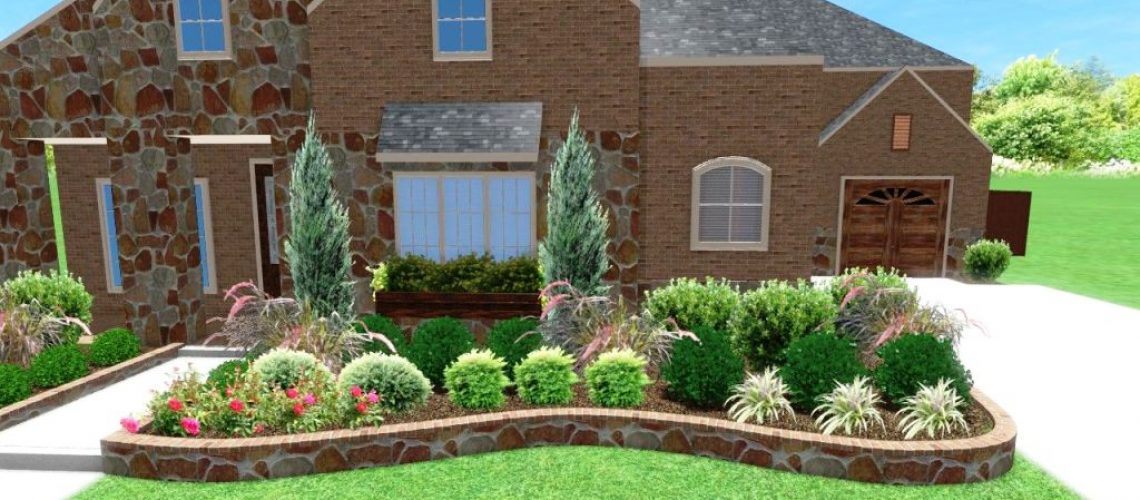
solvida
How Much Does it Cost to Install Stone Landscape Edging?
The majority of homes in the far North Dallas area have been built with great landscaping potential. Your average, builder-grade home will provide you with at least one garden bed area in your front yard. A great way to enhance the look of your garden bed and help to prevent grass from encroaching on your plants will be to install a stone wall or stone landscape edging along the perimeter of the garden bed. Perhaps you have had the same idea and actually inquired with local landscaping companies for an estimate for this stonework. You might be surprised at the difference in cost if you have had a chance to shop around for estimates. There are many variables that go into determining the cost to install stone landscape edging or a stone wall, so here are some things to keep in mind.
What Kind of Stone to Use?
Stone edging can be assembled with a great variety of stones: Chopped Stone, Boulder Stone, Brick and Manufactured Stone. Manufactured stone is typically made from concrete and comes in uniform shapes and sizes. Brick will also offer you uniformity in size and shape. Chopped stone resembles a long brick and is available in a variety of natural stones that have been machine cut into various heights and lengths. Your average chopped stone comes in 4”, 6” and 8” height and can be chiseled or machine cut into smaller shapes. Boulder stone has no uniformity to it at all and the size can range between 10” – 2’ tall. You should select a stone that reflects the look you would like to achieve. Boulder stones are the most rustic and natural-looking option. They can also be combined with chopped stone to give a beautiful combination look. If you prefer something more uniform in nature, then consider using a manufactured stone or brick.
Should You Dry Stack or Mortar?
One of the very first questions a reputable landscaping company will ask you is how you would like to the wall constructed. The options are either “dry-stacked” or “mortared”. Dry-stacking involves digging a trench along the perimeter of the garden bed approximately 2-4 inches deep (depending on the size of the stone) and placing the stones right next to each other. If you require a stone wall that will be more than one row high, we would recommend providing a sand base to the stonework and taking care to dig a trench to varying depths to provide a finished stone wall that is level. One benefit to dry-stacking your stonework is that it can be more cost effective. In addition, our ground is constantly shifting and stones that have been simply stacked in place are much easier to re-stack. The downside of dry-stacking is that the stones are not secured in place and will provide openings for grass to penetrate the garden bed. Dry-stacking is a great option for boulder stones, manufactured stones with an anchoring system or for decorative chopped stone walls that will not be more than 1-2 rows high.
A mortared stone wall simply means that the individual stones have been secured together using mortar (mixture of water, sand and cement). Mortar would be used on the bottom and sides of each stone, with no bubbles or gaps. While masons each have their own individual methods and styles, most mortar joints should be between approximately 0.5-1-inch wide. The end result is a stone wall that creates a solid barrier. This is a great choice for stone walls that need to be several rows high and provide a barrier to prevent grass growth into the garden bed. Be aware that grass grows on runners approximately 3-4 inches below the soil line. In order to truly prevent growth into beds, the trench for your stone wall should be at least this deep, if not deeper.
Preventing Cracks in Your Stone Wall
Due to the shifting nature of our soil, mortared stonework is always at risk for cracking. The best way to prevent cracking is to provide a concrete base for your stonework. For walls between 1-2 rows high, you will want to provide a concrete base at least 2 inches in depth. For walls with more than 2 rows, you will want your concrete base to include rebar and be poured to a depth of at least 4 inches. This solid base will provide a barrier between your stonework and the shifting ground below. Water is another element that can cause shifting and weakening to your mortar joints. To accommodate for water, ensure your mortared stone wall has weeping holes that allow water an exit from the garden bed. Address any possible irrigation leaks as soon as possible to prevent water from sitting inside the bed.
Average Cost to Build Stone Wall Edging?
As you can see from the information above, there are a wide range of options when it comes to stone wall materials and installation type. On average, installing a dry-stacked stone wall will cost between $12-18 per linear ft. For mortared stonework, you can expect to pay between $25-$30 per linear ft for a stone wall with a thin bed of concrete and up to $35 per linear ft for a thick bed of concrete with rebar.
Masonry work is an art form and when done well, it can provide your landscaping with utility as well as add thousands of dollars to your property value. Invest in a respectable and experienced landscaping company who employs qualified masonry workers. Done well, your stonework will stand the test of time.